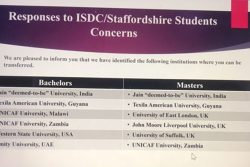MIAMI, (Reuters) – Latino activist groups had hoped to showcase their rising political power in the U.S. presidential election by blocking Republican Donald Trump in battleground states, and stopping him from ever acting on his tough views on immigration.
The voters came, but Trump won anyway.
“There is going to be a lot of finger-pointing,” said Frank Sharry, executive director of immigrants’ rights group America’s Voice. But, he added, “Latinos did their part.”
Reuters/Ipsos Election Day polling showed that America’s surging population of Hispanic voters heavily favoured Democrat Hillary Clinton across a swath of hotly contested states but may have been overwhelmed by underestimated support for Trump.
The former secretary of state won about 66 percent of Latino votes nationwide, versus 28 percent for Trump, according to the survey of around 45,000 people who cast ballots.
But that support lagged President Barack Obama’s 70 percent backing from Hispanics during his 2012 re-election campaign, and was not enough to counter an outpouring of support for Trump among his core demographics – older voters, whites, and those without college degrees.
“I think that there was a general underestimation of white turnout in support for Donald Trump,” said Luis Ricardo Fraga, co-director of the Institute for Latino Studies at Notre Dame. “There is some indication that Latino turnout in key states went up substantially, but white turnout went up even more.”
Turnout rates in Tuesday’s election are not yet available.
The election’s outcome is a blow for a rapidly growing segment of the population that has for decades relegated itself to the sidelines of American politics, and was looking to use opposition to Trump’s fiery anti-immigration rhetoric to broaden its influence.
Hispanics made up 17.6 of the country’s population in 2015, according to the Census, making them the largest ethnic minority. That’s up 12 percent from 2012. And by 2060, more than one-in-four people in America will be Latino.
“Donald Trump has just been a lightning rod for new voters and new engagement,” said Steve Slugocki, the chairman of the Maricopa County Democrats in Arizona.
INSULTS HIT A CHORD
Trump’s relationship with Hispanic voters began on an awkward footing when he launched his bid for the presidency in June 2015, calling for tighter borders and accusing Mexico of sending rapists and drug dealers into the United States.
He insisted he would force Mexico to pay for a multi-billion dollar wall along the border to keep unwanted foreigners out of the United States, and vowed to round up and deport the 11 million of undocumented immigrants already in the country.
Those positions, which became a cornerstone of his campaign, resonated on Tuesday among voters.
“When he said the Mexicans were rapists and all this, drug dealers and stuff, it did kind of hit a chord,” said Jazmin Gonzalez, 31, a Mexican-American from Barrio Logan in Southern California who voted for Clinton. “We know our people.”
Miguel Perez, a 49-year-old maintenance engineer in Southern California, who came to the United States from Mexico when he was 10, said he also voted for Clinton on Tuesday – mainly just to stop Trump.
“I would have voted for Donald Duck if I had to,” he said after casting his ballot at San Ysidro High School near the border with Mexico.
Clinton sought to contrast her campaign with Trump’s by advocating for a path to citizenship for most undocumented immigrants living in the country. She also hired immigrant activists to her campaign, and featured undocumented immigrants at rallies.
But she and the Democratic Party had at times raised the ire of Latino activists by focusing too heavily on bashing Trump while putting forward less-than substantive efforts to appeal directly to Latinos.
Latino organizations also lobbied Clinton to pick an Hispanic running mate, floating names like Labor Secretary Tom Perez and Secretary of Housing and Urban Development Julian Castro for the job. She ultimately picked Tim Kaine, a senator from Virginia.
Latino activist groups nonetheless worked hard this year to mobilize a community that has typically voted at lower rates than both white and black voters. In 2008, less than half of Latinos who were eligible to cast ballots actually did – and the rate dipped in 2012, according to the Census.
In contrast, the voting rates for white and black voters were both well over 60 percent.
“From our point of view, it is really about understanding how to best engage a community, and then moving forward,” said Dorian Caal, director of civic engagement research at the National Association of Latino Elected and Appointed Officials.








